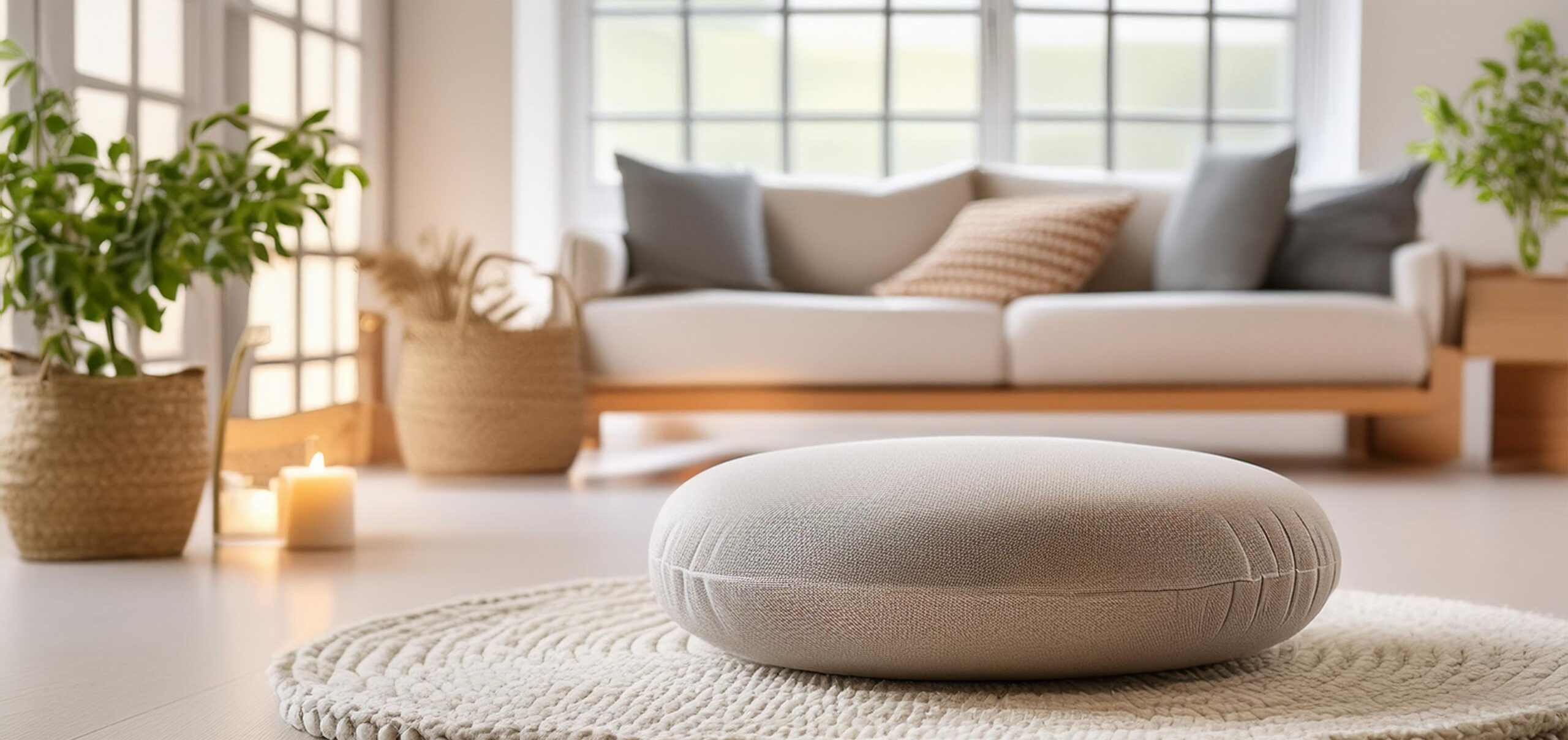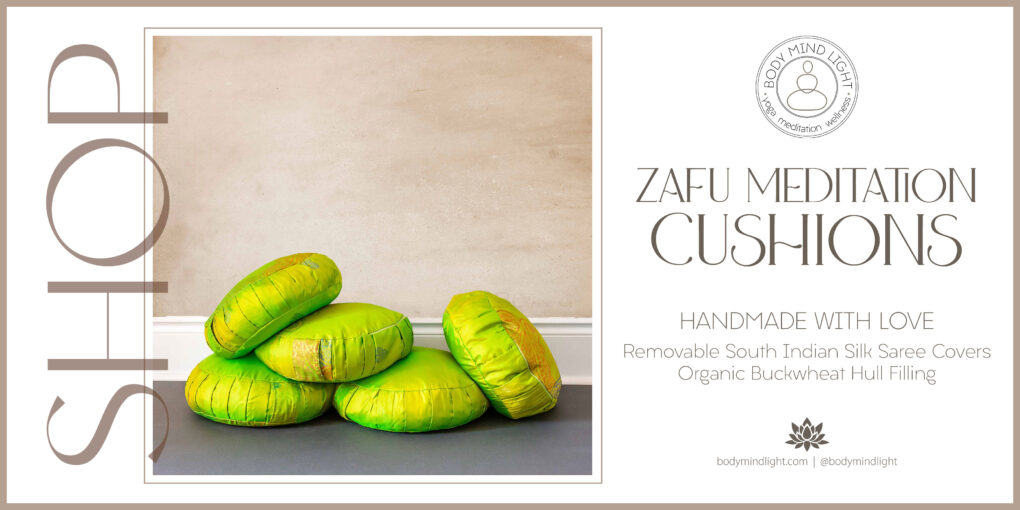Finding the Most Comfortable Meditation Cushion

Meditation is a deeply personal and transformative practice, and having the right meditation cushion can make all the difference in achieving a comfortable and focused meditative state. In this guide, we’ll explore the purpose, types and benefits of this yoga and meditation tool, as well as tips for finding the most comfortable meditation cushion to enhance your practice.
What is a Meditation Cushion?
A meditation cushion, often referred to as a meditation pillow, a pouf or a zafu, is a specially designed cushion that provides support and comfort in seated poses during the practice of yoga and meditation.
The main types of modern cushions include the traditional round zafu, the rectangular zabuton (which is often used underneath a zafu to provide additional cushioning for the knees and ankles), the crescent-shaped cushion, which offers enhanced thigh support and reduces knee strain, and the meditation bench, which is typically used for kneeling positions, providing support to the lower back and allowing for a straight spine. Each type of cushion caters to different meditation styles and personal comfort needs.
Purpose & Benefits
Meditation cushions provide support and proper alignment by elevating the hips, allowing the knees to drop below the hip level. This improved stability and comfort reduces strain on the back and pelvis, making it easier to sit for extended periods. It also allows better focus, deeper concentration and a more profound meditative state. Here are some important benefits of using a meditation cushion:
- Better Comfort: The elevated position of the hips reduces pressure on the knees and ankles, thus encouraging circulation and minimizing the risk of injury due to strain.
- Improved Posture: A pillow or cushion helps to align the pelvis and lengthen the spine, allowing a healthy, natural curvature of the back.
- Increased Flexibility: Over time, a seated position on a cushion gently and safely opens up the joints of the hips, knees and ankles, thus releasing toxins and creating a more supple body.
- Deeper Focus & Concentration: When you feel comfortable and well-supported, it’s easier to focus on your breathing, become completely present and allow the meditative experience to occur.
- Enhanced Mindfulness & Awareness: A meditation cushion acts as a dedicated anchor to your practice of mindfulness. The level of awareness that you achieve with this tool ensures that you continue to stay mindful throughout your day.
Do You Need a Meditation Cushion?
First of all, do you even need a meditation cushion? If you choose to meditate on a chair or your preference is a supine position, you probably don’t even need one to begin with. In fact, even for seated positions, some people are quite content using a grass mat, a rolled up yoga mat or a tightly folded blanket. However, a consistent and regular yoga and meditation practitioner will probably find a good meditation cushion to be a worthwhile and wise investment.
That being said, pay attention to your individual support needs and consider your body type, flexibility and any physical limitations. If you have knee or back issues, you might consider a meditation bench instead of an actual cushion. If you are very tight, you may require a higher cushion to reduce strain and the risk of injury. If you need additional cushioning for your feet and knees, you may need a zabuton.
If possible, try out a few different cushions to discover the right size, shape, height and degree of firmness for your body. Many yoga studios and meditation centres offer a variety of cushions that you can test out.
Tips for Finding the Right Cushion
Comfort is paramount when selecting a meditation cushion. It should feel good for you, support your posture and reduce any physical discomfort that might distract you during meditation. Here are some important factors to consider when selecting most comfortable meditation cushion for you.
Filling
The filling of a meditation cushion greatly affects its comfort, longevity and effects on your meditation experience. Common fillings include:
- Buckwheat Hulls: This natural filling conforms to your body shape, providing excellent support and stability. Buckwheat hulls are also breathable, keeping you cool during meditation.
- Kapok: A natural, cotton-like fiber, kapok is lightweight and offers a firm but comfortable support. It’s less moldable than buckwheat but still a popular choice.
- Wool: Wool is lightweight and long-lasting, but not as firm. Known to promote good blood circulation, it serves as a resilient seating surface that maintains its shape over time.
- Memory Foam: For a modern touch, memory foam offers excellent support and molds to your body’s contours. It’s durable but may retain more heat than natural fillings.
Cover Fabric
The fabric of your meditation cushion is not only about aesthetics but also about comfort, durability and feel. Here are some popular materials:
- Cotton: Soft, breathable, and natural, cotton is a popular choice for meditation cushion covers. It’s also easy to clean and maintain.
- Linen: Linen offers a more luxurious feel and is highly durable. It’s a bit more expensive but worth the investment for its comfort and longevity.
- Velvet: For a plush and luxurious experience, velvet is an excellent choice. It’s softer than cotton and adds a touch of elegance to your meditation space.
- Silk: Silk has a luxurious and smooth texture, enhancing the sensory experience of meditation while offering a sophisticated and elegant appearance.
- Hemp: A sustainable and eco-friendly option, hemp is durable and has a unique, earthy texture. It’s a great choice for those who prioritize environmentally friendly materials.
Cleaning & Maintenance
Keeping your meditation cushion clean is essential for maintaining a hygienic and pleasant meditation practice. Consider the following tips:
- Removable Covers: Cushions with removable and machine-washable covers are the easiest to maintain. Look for covers with sturdy zippers that can withstand frequent washing.
- Stain-Resistant Fabrics: Some cushions are made with fabrics that resist stains and spills, making them easier to clean.
- Spot Cleaning: If your cushion doesn’t have a removable cover, ensure the fabric can withstand spot cleaning without damage.
- Portability: look for cushions that come with built-in handles which make it easier to carry around, especially if you change spaces often, or if you travel to attend yoga classes and meditation retreats.
Choosing the ideal meditation cushion is a personal journey that involves considering your unique needs and preferences. By considering several factors such as comfort level, height, fabric, materials, filling, portability, and ease of cleaning, you can find a cushion that enhances your meditation practice and supports your journey to mindfulness and inner peace. Remember, the best cushion is one that feels right for you and supports your practice in the most comfortable way possible!


Very informative article, thanks!
Do buckwheat hulls aggravate allergies?
Buckwheat hulls in itself can be a food allergen, but when it comes to cushions and pillows, they actually have natural properties that repel bacteria and dust mites.